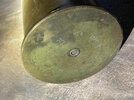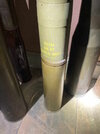A question concerning the above which I feel will mostly only be answerable by our colleagues from the US.
The M67 was originally a fixed, non charge adjustable round that used the Type II cartridge case with crimps to secure the projectile in the mouth of the case. This information from various manuals. Then it all changed and it became a semi fixed round using Type I cases as did all the other projectile types. I have some cases in my collection that have the II of Type II barred out and a I substituted, so making it a Type I case....but there are no crimps on the cases.
My question is....does anyone out there actually have a Type II case with crimp marks still present.
There is massive confusion in the manuals, the wording describing the M67 states they are semi fixed but the diagram clearly shows crimps. A footnote states that the charge is non adjustable....
I have 2 M67 projectiles in my collection. A WW2 one obtained in Normandy has a groove for a case to be crimped into as well as the normal groove just below the driving band for the driving band to set back into.
A second projectile is a post war German 105mm How H/l M67 without the crimp groove but still with the set back groove below the driving band.
Thank you for an help to clarify this. Sorry to be so esoteric, I just need to know....PLEASE
The M67 was originally a fixed, non charge adjustable round that used the Type II cartridge case with crimps to secure the projectile in the mouth of the case. This information from various manuals. Then it all changed and it became a semi fixed round using Type I cases as did all the other projectile types. I have some cases in my collection that have the II of Type II barred out and a I substituted, so making it a Type I case....but there are no crimps on the cases.
My question is....does anyone out there actually have a Type II case with crimp marks still present.
There is massive confusion in the manuals, the wording describing the M67 states they are semi fixed but the diagram clearly shows crimps. A footnote states that the charge is non adjustable....
I have 2 M67 projectiles in my collection. A WW2 one obtained in Normandy has a groove for a case to be crimped into as well as the normal groove just below the driving band for the driving band to set back into.
A second projectile is a post war German 105mm How H/l M67 without the crimp groove but still with the set back groove below the driving band.
Thank you for an help to clarify this. Sorry to be so esoteric, I just need to know....PLEASE


